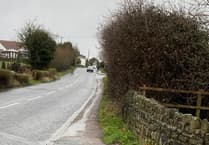PLANS to build hundreds of homes at the former Fairfield-Mabey Bridge shipbuilding site in Chepstow have moved a step closer to being realised.
The proposed development aims to pay homage to the industrial heritage of the site, while boosting the prosperity of Chepstow with a riverside park, a link to the Wales Coastal Path, leisure facilities and offices.
Monmouthshire councillors approved a reserved matters application for the scheme last week, after outline planning permission was first granted in 2017.
Under the plans, the neighbourhood will be split into three distinct areas including ‘New Chepstow’, ‘The Steelyard’ at the centre and ‘Hardwick Cliffs’ at the southernmost part of the site.
The majority of the homes, 244, will be three-bedroom properties and there will also be 79 four-bedroom and 22 two-bedroom houses.
Around 20-25 of the homes will be affordable housing on a 1.5-acre site.
At last week’s meeting, Chepstow councillor Armand Watts (Thornwell, Welsh Lab) questioned why the affordable units were being ‘tucked away’ and not being mixed with the rest of the development.
But a speaker from Barratt David Wilson Homes gave assurances that the cluster of houses would not cause “any sort of social ghetto” due to its small size.
Monmouthshire planning bosses said the scheme maximised the amount of affordable housing which could be included.
Councillor Louise Brown (Shirenewton, Con) praised the scheme, but questioned whether traffic issues should be considered now the Severn Bridge tolls have been abolished.
However, with outline permission already approved, issues such as traffic and the impact of the development on school capacity cannot be reconsidered at the reserved matter stage.
Chepstow councillor Jez Becker (St Mary’s, Lib Dem) said that although the scheme was “lacking in a lot of what was promised”, it still had many benefits that people of the town would “absolutely love.”
Councillor David Dovey (St Kingsmark, Welsh Con), said the scheme is “an incredibly important opportunity for the town” and that it would boost the area’s prosperity.
“If you do not like this, it begs the question what do you like, and what would we be likely to get,” he said.
“I think this is a really great opportunity for the town.”
Around 25 per cent of the homes will be three-storey, with the designs reflecting the site’s past history.
Fairfield Mabey’s factory ran from 1965 until 2009.
Before that, the site was part of Fairfields Shipbuilding and Engineering Company from 1924 to 1965.




